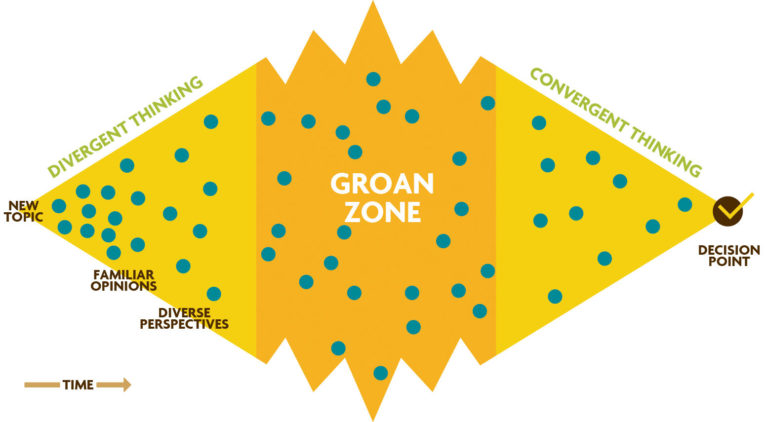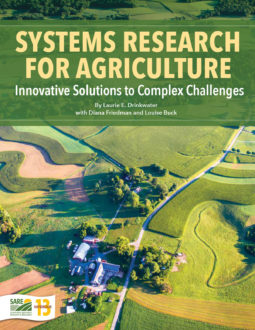Participatory decision-making in an interdisciplinary research team is challenging. While the team may easily identify a common goal, there are likely to be as many perceived pathways for reaching that goal as there are team members. However, democratic decision-making is essential for effective collaboration. The decision-making process is most visible in meeting settings, so the way in which meetings are conducted, especially around decision-making, affects the culture of collaboration.
Elements of Participatory Decision-Making

The “Diamond of Participatory Decision-Making,” by Kaner and colleagues (2014), provides one example of what participatory decision-making looks like as it aims to integrate diverse perspectives (Figure 2.4). Blue dots in the figure represent ideas shared among the group during the meeting. As familiar options give way to diverse perspectives, an unpleasant period of interaction occurs that can involve repetition, interruption, defensiveness and short tempers. The authors call this inevitable stage the “groan zone,” during which participants struggle to understand a wide range of foreign or opposing ideas. Significant creative breakthroughs evolve from this uncomfortable period if the process is facilitated in a caring and competent way.
The dynamics of the groan zone will be most apparent early in the project, when team members are becoming acquainted and developing relationships (the storming phase). At this formative stage, bring this dynamic to the group’s attention and be deliberate in facilitating the group through it. Later, when the group has transitioned to interacting as a more cohesive team, less time will be spent in “groan-zone” mode.
Kaner and colleagues (2014) identify six decision rules commonly used in participatory decision-making: (a) unanimous agreement (consensus), (b) majority vote, (c) person in charge decides without discussion, (d) flip a coin, (e) delegation, and (f) person in charge decides after discussion. A conventional project leader is likely to default to the “person in charge decides after discussion” rule. A team leader using the integrative or participatory method should challenge this assumption and help the team choose the best option.
Becoming a Good Facilitator
Skillful facilitation is essential for effective interdisciplinary decision-making; it fosters interaction, joint learning and participatory decision-making, it aids in building collaboration (Heron, 1999; Straus, 2002), and it helps a group do its best thinking (Kaner et al., 2014). A good facilitator eases the team through the groan zone by pointing out that this phase is normal and by using a variety of tools to help the team reach convergence of ideas and inclusive solutions.
A good facilitator will:
- Delegate responsibilities to all team members Prevent experts in certain fields from controlling meetings
- Encourage all team members to participate
- Ensure that everyone in a meeting works on the same problem using the same strategy
- Promote mutual understanding Foster inclusive solutions.
Useful Facilitation Techniques
Brainstorming, equivalent to “rough draft thinking,” involves a group drawing a list of ideas about what to do about an identified problem or need. A successful brainstorming session will: (a) encourage people to take turns; (b) treat all ideas with the nonjudgmental responses (verbal and nonverbal), regardless of how unreasonable or unrealistic an idea may sound; (c) create a lively atmosphere for the discussion; and (d) help the group keep time. It is important not to: (a) interrupt, (b) judge, (c) favor the “best” thinkers, (d) give up the first time the group seems stuck, (e) rush or pressure the group, or (f) fail to set a time limit. Breaking into small groups provides an alternative to open discussion. Small groups are effective for: (a) breaking the ice so people feel less exposed and therefore less reserved, (b) energizing people through activity, (c) deepening everyone’s understanding of a topic because there is more time to explore each person’s ideas, (d) exploring different aspects of a problem simultaneously, (e) building relationships, and (f) generating a greater commitment to the outcome. Stacking involves organizing the flow of an open discussion to allow people to take turns when several want to speak at once. Instead of competing for a chance to speak, people are free to listen. Stacking also enables a group to break habitual patterns of deference and favoritism. It is sometimes the simplest way to get a rigidly hierarchical group to make room for participation from low-status members. To facilitate stacking, poll the members about their interest in speaking about a topic or question raised. After a show of hands, make a list of names and call on each in turn for their contribution. When everyone on the list has spoken, depending on the time available and the importance of the issue, poll the group again to see who would like to expand on or offer a rebuttal to what has been said. Continue until it feels comfortable to bring the process to a close.
Structured go-around is a useful technique for framing a complex discussion, gathering diverse perspectives, returning from a break after a heated disagreement and coming to closure. The go-around occurs in a circle format so everyone’s face is visible. The main ground rule is that one person speaks at a time after the facilitator gives a brief overview of the topic.
The importance of developing basic facilitation skills cannot be overemphasized. That said, it may be unrealistic to expect agricultural scientists to also be expert facilitators; bringing in professional facilitators to help the project get started may be a good way to bridge this gap.
As the benefits of facilitative leadership become increasingly recognized, agricultural colleges and universities are beginning to offer training workshops for scientists, educators, farmers and other professionals working on agricultural systems research. Project leaders should consider attending such a workshop. If the project can afford it, a reputable facilitator can organize a training tailored to the project’s needs that can help the team gain the insight and skills needed to share leadership responsibilities effectively.
